 W
WThis list of wound decorations is an index of articles that describe notable awards given for wounds; usually, though not exclusively, to military personnel during wartime.
 W
WThe DEA Purple Heart Award is an award given by the United States Drug Enforcement Administration to honor individuals who had lost their lives or been seriously injured enforcing the drug laws of the United States.
 W
WThe Elizabeth Cross is a commemorative emblem given to the recognised next of kin of members of the British Armed Forces killed in action or as a result of a terrorist attack after the Second World War. It bears the name of the current British monarch, Queen Elizabeth II.
 W
WThe Insigne des blessés civils is a French distinction for civilians, irrespective of age or sex, who have been injured or maimed as a result of war.
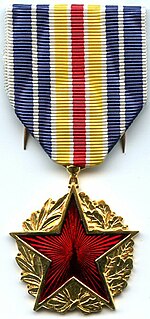 W
WThe Medal for the War Wounded was originally a mere insignia in the form of an ribbon awarded for wounds received in the line of duty while facing an enemy. The insignia was established by the law of 11 December 1916, based on an idea by the nationalist writer Maurice Barrès. Although originally established as a temporary measure, the insignia survived for a century in some form or another. It could be awarded to wounded soldiers, prisoners of war, to World War II deportees and internees from the French resistance and to soldiers wounded in more recent conflicts. A variety of unofficial medals in the form of a red enamelled star suspended by the same ribbon appeared very early on and although tolerated for wear by the authorities, were not official until recently.
 W
WThe Memorial Cross, often known as the Silver Cross for Mothers, is a Canadian medal awarded to the mother, widow, widower, or next of kin of any member of the Canadian Forces who loses their life on active service, including peacekeeping, other such international operations and, since 2001, other service related deaths.
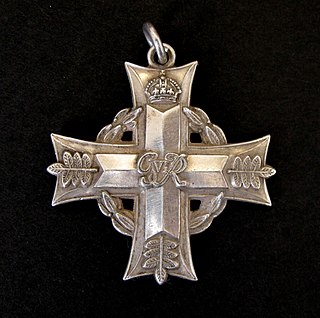 W
WThe New Zealand Memorial Cross is awarded to the next of kin of New Zealand service personnel who, since September 1939, have been killed on active service or later died of their wounds.
 W
WOrder of the Croatian Cross is the 15th important medal given by Republic of Croatia. The order was founded on April 1, 1995.
 W
WThe Order of the Cross of Liberty is one of three official state orders in Finland, along with the Order of the White Rose of Finland and the Order of the Lion of Finland.
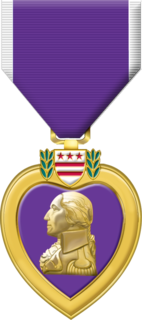 W
WThe Purple Heart (PH) is a United States military decoration awarded in the name of the President to those wounded or killed while serving, on or after April 5, 1917, with the U.S. military. With its forerunner, the Badge of Military Merit, which took the form of a heart made of purple cloth, the Purple Heart is the oldest military award still given to U.S. military members – the only earlier award being the obsolete Fidelity Medallion. The National Purple Heart Hall of Honor is located in New Windsor, New York.
 W
WThe Sacrifice Medal is a decoration that was created in 2008 as a replacement for the Wound Stripe. It is awarded by the Canadian monarch, usually by the Governor General of Canada, to members of the Canadian Forces or allied forces wounded or killed in action, and to members whose death under honourable circumstances is a result of injury or disease related directly to military service.
 W
WThe Secretary of Defense Medal for the Defense of Freedom is a decoration established to acknowledge civilian employees of the United States Department of Defense (DoD) who are killed or wounded in the line of duty.
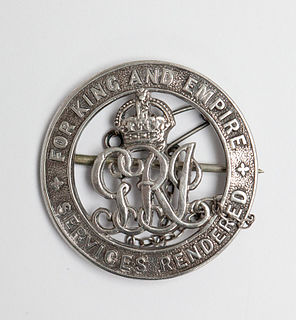 W
WThe Silver War Badge was issued in the United Kingdom and the British Empire to service personnel who had been honourably discharged due to wounds or sickness from military service in World War I. The badge, sometimes known as the "Discharge Badge", the "Wound Badge" or "Services Rendered Badge", was first issued in September 1916, along with an official certificate of entitlement.
 W
WThe Wound Badge was a German military decoration first promulgated by Wilhelm II, German Emperor on 3 March 1918, which was first awarded to soldiers of the German Army who were wounded during World War I. Between the world wars, it was awarded to members of the German armed forces who fought on the Nationalist side of the Spanish Civil War, 1938–39, and received combat related wounds. It was awarded to members in the Reichswehr, the Wehrmacht, SS and the auxiliary service organizations during World War II. After March 1943, due to the increasing number of Allied bombings, it was also awarded to civilians wounded in air raids. It was awarded when the wound was the result of enemy hostile action. In 1957, the West German government authorized a denazified version of the basic badges for wear on the Bundeswehr uniform, among other certain Nazi-era wartime awards.
 W
WA Wound Chevron was a badge of the United States Army, United States Navy and United States Marine Corps which was authorized for wear on uniforms between the years of 1918 and 1932. The Wound Chevron was a gold metallic-thread chevron on an Olive Drab backing displayed on the lower right cuff of a US military uniform. It denoted wounds which were received in combat against an enemy force or hospitalization following a gassing.
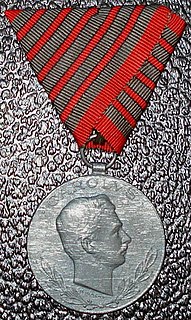 W
WThe Wound Medal was a decoration of the Empire of Austria-Hungary. It was established on August 12, 1917 by Emperor Karl and was the last medal to be officially founded in the empire.
 W
WThe Wound Medal was established by the Independent State of Croatia "in honor of those who, as homeland defenders, were wounded or injured during combat with the enemy".
 W
WThe Republic of Vietnam Wound Medal was a military decoration of South Vietnam first created in 1953. The medal was the South Vietnamese equivalent of the United States military's Purple Heart, and was awarded to any personnel of the South Vietnamese military who, while engaged in armed combat with enemies of the Republic of Vietnam, were either wounded or killed in action.